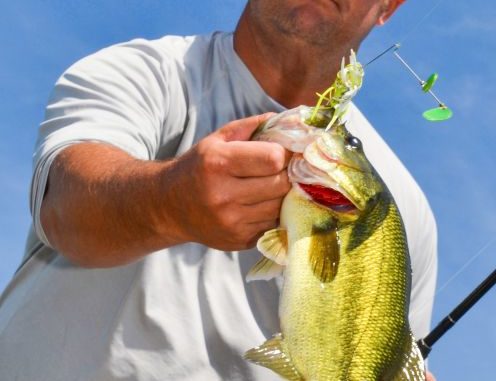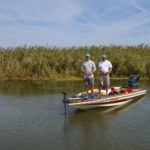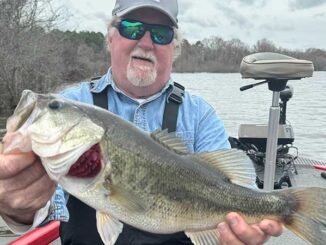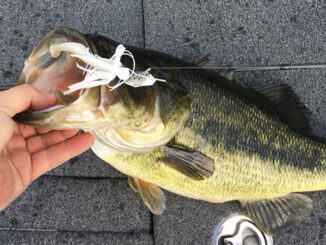
Don’t let September fronts scare you away from bass fishing. Just head to Venice, where the bass go nuts when high pressure and falling tides prevail.
When I was a kid, a big lie was called a “humdinger,” as in “That Billy Bob shore tole a humdinger!”
Nowadays, the dictionary definition seems to have settled on a humdinger being something extraordinary or outstanding.
I’m sure this definition is the one Tony Landry prefers.
He’s the owner of Donaldsonville’s T&J Lures, the maker of Humdinger Spinners, as well as jigs, buzz baits and Keith Poche Power Spinners.
The tall, 40-year-old former athlete is quick to tell you that making safety pin-type spinnerbaits is a hobby that turned into a business.
Landry grew up bass fishing in the Atchafalaya Basin with his father Henry, but he didn’t turn to tournament bass fishing until after his college baseball and football experience, when he found that he missed competition.
“(Tournament fishing) allows you to measure yourself,” he said. “Everybody says how good they are, but until you measure it, you really don’t know.”
Landry has owned the lure company since 2010.
“We all grew up using Humdingers,” he said. “My dad fished with the owner’s brother-in-law for two or three years. One day, I told him that if Mr. Joe ever wanted to sell the business I would be interested.
“He didn’t think I was serious at first.”
The company, then named T&T Lures, was owned by Joe and Dottie Territo after they purchased it from the founder of the company, Jimbo Robertson
The Territos had been hand-making the spinners with Dottie’s sisters since 1987. At the same time, Joe was employed at a power plant.
Landry’s query came at the right time: Territo was ready to retire, so Landry and his wife Patricia closed the deal.
“Tony had been making imitations with modifications of Humdingers for years,” close friend and fishing partner Willie Couch III said. “When he bought the company, he didn’t have to spend 30 minutes making each bait anymore.
“On a good weekend, you can go through 20 spinnerbaits. One redfish can destroy a bait.”
Redfish love safety pin spinners, a blessing for some fishermen but an aggravation for tournament bass fishermen.
When Landry and Couch invited me on a fishing excursion to Venice, I jumped all over the offer, not as much for the fishing but for the chance to pick the mind of a spinnerbait expert.
Couch is a member of the near-legendary Couch fishing family from St. Charles Parish. His grandfather, Dr. Wilson Couch, was a well-known blue-water big-game fisherman.
All the elder Couch’s sons fished. David and Steve were best known as spearfishermen. Willie Jr. was a tournament bass fisherman, an addiction he passed to his son Willie III, who describes himself as “ate-up with bass fishing.”
He estimated, with a self-conscious shrug, that he fishes roughly 100 days a year.
Accompanying the pair on this trip was Tony’s 10-year-old son Jackson and a big friendly bear of a man named Chance Morse from Robert.
Morse bass fishes in Venice roughly 50 days a year and was tagged as “the local expert” by Couch. Morse and young Jackson would be fishing in a second boat, but in cooperation with Landry and Couch.
The men took their time launching their boats for the long run from Venice to Head of Passes, where the great river breaks into Southwest Pass, South Pass and Pass a Loutre.
“Venice is my favorite place to fish in Louisiana,” Couch said while idling out of the marina. “It is different than any place else; it’s the only place you launch your boat to fish bass next to a boat launching to fish for marlin.”
Landry agreed.
“You never know what you are going to catch,” he said. “You may get a bass on one cast and a redfish on another.”
Couch also said there’s another reason he loves the place.
“Another thing is just the thrill of coming down here,” he explained. “When you leave the marina, you get an unsettling feeling: You’re sharing the water with ocean-going ships.
“In the 20-mile run you never know what to expect — you can run on a sandbar, (or battle) fog and wind. If your electronics fail, you could get lost. Or you just might tear the fish up.”
That means anglers should never head out blind.
“Good electronics or paper maps are important,” Landry said. “It’s a good idea to hire a guide or come with someone who has been here before when you make your first trip.”
The north wind following an early cool front on top of a big tide range promised extremely low tides later in the morning.
Which made for perfect fishing conditions.
“The more water that comes out of the canes the better,” Couch explained.
The “canes” he referred to are roseau canes — 10-foot tall reeds, so densely packed that it is virtually impossible to force a human body through them, yet with enough openings for bass to enter and leave their shelter as they wish.
The day’s fishing was done on the eastern side of the delta. The larger passes sprang smaller passes, often called “spillways” by Venice regulars, and these open into shallow ponds or fragment into smaller waterways that in turn open into ponds.
Young Jackson quickly scored the first bass of the day while both boats were in the same bayou. He was followed by his dad, who wrestled in a chunky redfish.
“These are really a common bycatch on spinners, but we usually leave these when we find them,” the elder Landry said. “They break your baits.”
The day started slowly, as Couch predicted.
With the high tide early, the fish were still hugging the canes. The rapidly falling tide augmented by a persistent north wind following the cool front was expected to push the water from the canes.
North winds, high barometric pressure and cloudless blue skies are usually the kiss of death for bass fishing elsewhere.
But Venice is different.
“Venice is very untypical, in that you do best on high-pressure, blue-sky days right after a front,” Couch said. “Even without a front, you get more bites on sunny days than cloudy days.”
The more the tide fell, the more bass were found lurking around the beds of submerged grasses of the cuts and sloughs.
Spinnerbaits were effective around this salad, where treble-hooked lures would have impossible to work.
Couch grinned unselfconsciously as his predictions came through on the day.
“Venice is the best in the country when the river is low, below 4 feet on the New Orleans gauge,” he said. “August through December is good; September is very good.
“October and November are prime.”








